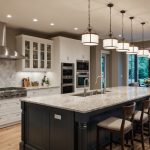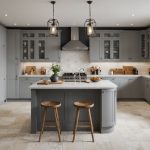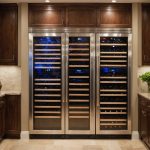Understanding the Importance of a Calm Kitchen Environment
Creating a calm kitchen environment is not only about aesthetics but plays a significant role in enhancing mental well-being. A serene kitchen can be a sanctuary where the stresses of daily life are gently pushed aside. It can offer a space that promotes mindfulness and relaxation. When the kitchen is designed with peace in mind, it becomes a crucial element in maintaining psychological balance.
From natural lighting to soothing colours, the design elements of a kitchen impact our mood significantly. Spaces that are clutter-free and thoughtfully organized encourage a sense of control and clarity. This organisation reduces mental clutter, thereby alleviating anxiety and stress. A well-designed kitchen fosters a welcoming atmosphere that encourages users to engage with their surroundings more meaningfully.
This might interest you : Revamp your culinary oasis: an inspiring guide to modular kitchen designs for seamless upgrades
Furthermore, the kitchen can serve as a hub for mindfulness practices. Cooking, for example, becomes more than a chore; it transforms into a meditative activity. Activities like chopping, stirring, or even cleaning give an opportunity to be present, experience the moment, and promote mental relaxation. Designing a calm kitchen is essentially about crafting a space where peace and mindfulness coexist, contributing directly to improvement in mental health.
Key Design Strategies for a Serenity Sanctuary
When considering design tips for crafting a peaceful kitchen that embodies a sanctuary style, the layout plays a critical role. Begin by integrating open layouts to enhance flow and reduce clutter. Open spaces not only improve the movement within the kitchen but also create a feeling of spaciousness, crucial for cultivating a serene atmosphere. Avoid bulky cabinets and opt for sleek, floating shelves to further support this design concept.
Also read : Maximize your kitchen”s charm: expert tips for positioning your ideal wine cooler
Incorporating ergonomic design elements advances comfort and ease of use in your kitchen sanctuary. Choose countertops at an optimal height to prevent strain during meal preparations. Consider ergonomic handles on cabinetry and appliances to facilitate ease of access. These thoughtful adjustments not only add to user comfort but also subtly echo the sanctuary ethos in their user-friendly design.
The importance of a multifunctional space that supports various kitchen activities cannot be overstated. By accommodating several functions, your kitchen becomes a versatile retreat. Designate zones within the space for different activities such as cooking, dining, and entertaining, ensuring seamless transitions between them. This approach enhances the kitchen’s functionality, allowing it to serve as a harmonious sanctuary suited to diverse needs, blending practicality with tranquility.
Color Schemes that Promote Relaxation
Understanding color psychology can significantly enhance the serenity of a space. When selecting a color palette for relaxation, it’s vital to choose hues that naturally soothe the senses. Soft shades, often dubbed as calming colors, are usually the go-to choice. These tones tend to include pastel blues, gentle greens, and muted greys, creating a tranquil and serene ambiance.
Natural tones have a profound impact on a room’s atmosphere. They mimic elements found in nature, which inherently calm the mind. For instance, the soft greens reminiscent of a lush forest, or the pale blues akin to a clear sky, can infuse a space with serenity. On the other hand, vibrant hues, while striking, may overstimulate the senses and disrupt relaxation. Opting for serene palettes that leverage subtle contrasts can maintain equilibrium within a room.
To maintain tranquility, accent walls can cleverly introduce calming colors without overwhelming the space. Incorporating subtle contrasts allows for refreshed perspectives without straying too far from the primary serene palette. This approach is not only visually appealing but also promotes a state of relaxation that is both inviting and sustainable.
Materials and Finishes that Enhance Serenity
Incorporating natural materials into your space can greatly contribute to a serene and calming atmosphere. These materials, such as wood, stone, and bamboo, not only reduce environmental impact but also bring a touch of nature indoors, which is often associated with peace and tranquillity. Choosing finishes with soft textures, like matte or satin, can further enhance tactile comfort, allowing for a more inviting and comforting environment.
Finishes with texture are important for both aesthetic appeal and functionality. Textured surfaces like rough stone or woven fabrics add visual interest and can also hide wear and tear better than smooth finishes. This makes them suitable for high-traffic areas where functionality can’t be sacrificed for aesthetics.
Balancing these elements is crucial. While it’s essential to choose materials that appeal to the senses and create comfort, they must also serve the intended function of the space. For example, while a plush carpet may offer softness and warmth underfoot, it may not be ideal for a kitchen where durability and ease of cleaning are priorities over tactile comfort.
In conclusion, selecting the right natural materials and finishes can create a harmonious blend of aesthetics and functionality, elevating the serenity of any environment.
Sensory Elements for a Tranquil Kitchen
Creating a peaceful kitchen relies heavily on sensory design. One of the key elements is lighting. Soft, diffused lights have been shown to influence mood positively, instilling a sense of calm. Adjusting brightness levels according to the time of day helps maintain a tranquil ambiance, making the space inviting and soothing.
Beyond lighting, scents and sounds play a crucial role in cultivating a serene atmosphere. Using natural oils, like lavender or eucalyptus, can have a calming effect. Scented candles or diffusers are simple ways to enhance your kitchen’s peaceful ambiance. Additionally, incorporating gentle background sounds such as soft music or nature sounds can mask unwanted noise, helping maintain tranquility.
Integrating plants into your kitchen design not only brings nature indoors but also improves air quality and promotes relaxation. Houseplants like spider plants or peace lilies are excellent choices because they require minimal maintenance while offering numerous benefits. Natural materials, such as wood and stone, further enhance a natural setting and add to the calming presence, assisting in fostering a balanced environment.
By focusing on sensory design — optimizing lighting, ambiance, scents, and natural elements — the kitchen can transform from a functional space into a sanctuary of tranquility and comfort.
Organizing Your Space for a Stress-Free Experience
Bringing order to your kitchen can significantly transform it into a haven of efficiency and calm. One effective approach is categorising your belongings. Store items you use frequently in easily accessible spots, while relegating rarely-used ones to higher shelves or drawers. This method ensures your routine is smooth and unencumbered.
Decluttering is your next crucial step. Adopt the rule: “If you haven’t used it in the last year, it’s time to let go.” Donate, recycle, or discard the excess. This clears physical and mental space, fostering peace and focus.
Investing in clever storage solutions can further enhance your kitchen environment. Use clear container sets for pantry staples, allowing you to see contents easily. Stackable storage or tiered racks can also optimize cabinet space, keeping everything orderly.
For keeping frequently-used items within reach yet hidden, consider retractable drawers or rotating shelves in corner cabinets. These innovations offer both accessibility and a clutter-free appearance.
Employ hooks and magnetic strips to store utensils and tools neatly. This way, you maintain an efficient kitchen where everything has its place. By implementing these organization tips, you streamline meal preparations, reduce stress, and increase the enjoyment of daily activities in your kitchen.
Expert Insights and Case Studies
To gain deeper understanding into kitchen designs, it’s crucial to consider insights from experienced interior designers. These experts often emphasise the role of natural elements and minimalistic styles in promoting a sense of calm and well-being. For instance, an interior designer might suggest incorporating natural wood finishes and neutral colour palettes to create a serene environment.
Transformation stories are a testament to the power of thoughtful design in enhancing a space. One such example is a renovation where an outdated kitchen was converted into a modern, light-filled haven. The addition of large windows not only allowed for more natural light but also created a connection with the outdoor landscape, enhancing the overall mood of the space.
In analysing common themes in kitchen designs, it becomes apparent that many successful transformations share elements of simplicity and functionality. A frequent feature in these designs is the use of open shelving, which reduces clutter and provides a visually appealing way to store essential items.
Such insights and expert advice prove invaluable for those seeking to create a peaceful kitchen space. By focusing on these elements, homeowners can design kitchens that not only meet their functional needs but also contribute positively to their overall well-being.











